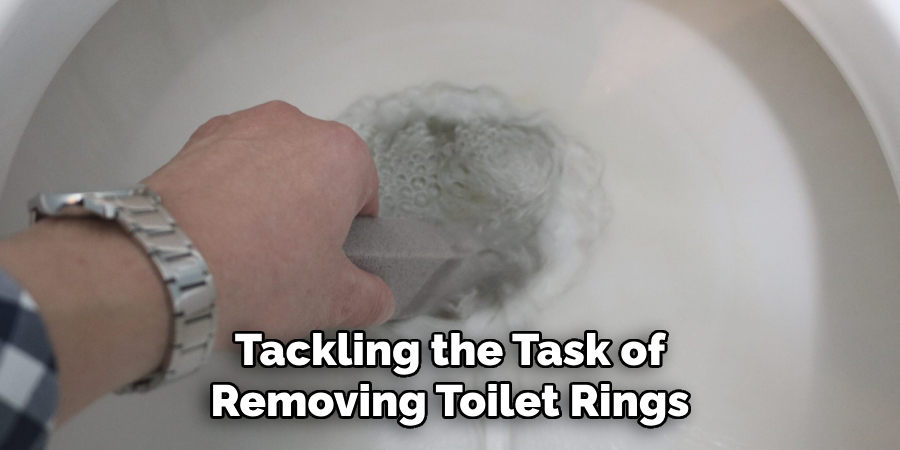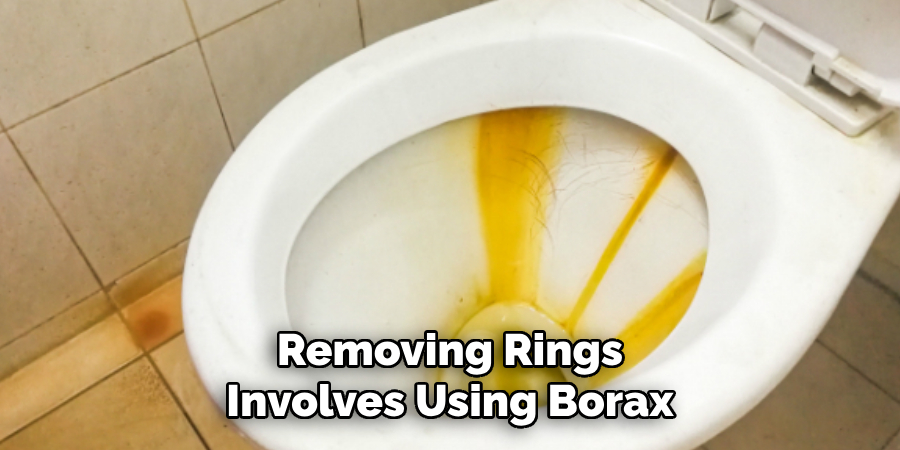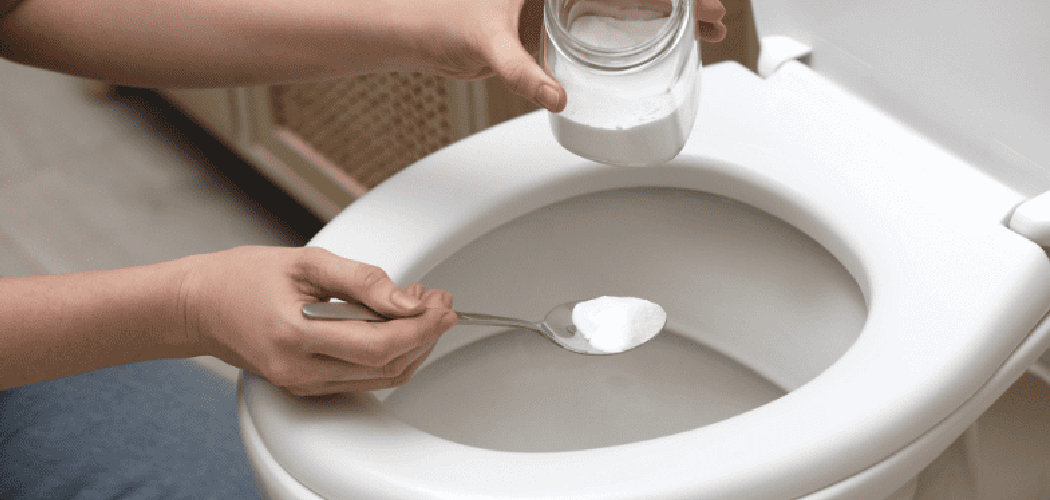Rings in the toilet bowl can be an unsightly nuisance and a sign of mineral buildup or hard water stains. Over time, improper cleaning and maintenance can lead to the accumulation of these unsightly rings. The importance of removing toilet rings goes beyond just aesthetics. Regular cleaning not only improves the appearance of your toilet but also plays a crucial role in maintaining hygiene.

It helps prevent the growth of bacteria and other unpleasant odors that might arise from neglect. Understanding how to remove rings from toilet bowls is essential for ensuring a clean and sanitary bathroom environment. This guide will provide step-by-step instructions on effectively removing rings from your toilet, using common household items, and safe cleaning techniques.
Tools and Materials You Will Need
To effectively tackle the issue of how to remove rings from toilet bowls, you’ll require some basic tools and materials. Essential tools include a toilet brush, a scrub brush or sponge, and rubber gloves to ensure hygiene and protect your hands. As for materials, you’ll need baking soda and vinegar, known for their natural cleaning prowess. Additionally, borax can be used as an optional cleaner for more stubborn stains.
A pumice stone is recommended for tackling particularly stubborn stains that resist standard cleaning techniques. A commercial toilet bowl cleaner can serve as an optional supplement for added cleaning power. Finally, have a bucket or sponge handy for easy cleanup after the job is done. Equipped with these tools and materials, you will be prepared to restore your toilet to a pristine state.
Safety Precautions
When tackling the task of removing toilet rings, it is essential to prioritize safety by following a few key precautions. Wear Protective Gear: Always start by wearing rubber gloves to shield your hands from harsh chemicals and bacteria present in the toilet bowl. If you’re using particularly strong cleaning agents, consider donning a mask to protect yourself from potential fumes.
Ensure Good Ventilation: Adequate ventilation is crucial when using potent cleaning products. Make sure to open windows and activate exhaust fans to facilitate airflow and prevent the inhalation of harmful vapors. Avoid Mixing Chemicals: One of the most critical safety tips is to never mix different cleaning products, as combining chemicals, particularly those containing bleach and ammonia, can produce toxic gases. To minimize risk, stick to using one cleaning method at a time. These precautions will help ensure a safe and effective cleaning experience.

Preparing the Toilet for Cleaning
Preparing your toilet for cleaning is a crucial first step in effectively removing those persistent rings. Following these simple preparations ensures a smoother, more efficient cleaning process.
Step 1: Gather Supplies
First, collect all necessary tools and materials to avoid interruptions once you begin cleaning. Make sure you have your toilet brush, scrub brush or sponge, rubber gloves, and your chosen cleaning agents—whether baking soda and vinegar for a natural solution, or a commercial toilet cleaner for more persistent stains. Having everything within reach will streamline the process and enhance your efficiency.
Step 2: Remove Excess Water
To maximize the effectiveness of your cleaning session, it’s beneficial to remove excess water from the toilet bowl. Begin by using a sponge or bucket to soak up the water, aiming to lower the water level and fully expose the rings you’re targeting. This step not only makes it easier to apply cleaning agents directly to the affected areas but also enhances their effectiveness. A simple trick is to flush the toilet, which helps to remove some water naturally but be sure to retain enough water to ensure optimal cleaning.
Step 3: Apply Cleaning Agent
Now that you have clear access to the rings, it’s time to apply your chosen cleaning agent. For those opting for a natural approach, sprinkle approximately 1 cup of baking soda followed by 1-2 cups of vinegar onto the affected area. Allow this mixture to fizz, as the reaction between baking soda and vinegar helps to break down the stains. Alternatively, if you’re using a commercial toilet cleaner, carefully follow the label’s instructions and apply the product generously around the ring and under the rim. This targeted application ensures the cleaning agent has direct contact with the stains, working to restore your toilet to its pristine condition.

How to Remove Rings from Toilet: Cleaning the Rings
Step 1: Let the Cleaner Sit
With your chosen cleaning agent applied to the toilet rings, it’s essential to allow it some time to work its magic. Whether you’re using the natural baking soda and vinegar solution or a commercial cleanser, let it sit undisturbed for at least 10-15 minutes. This period allows the cleaner to effectively break down the mineral buildup and embedded stains that form the unsightly ring. The fizzing action of baking soda and vinegar, in particular, helps to loosen even the most stubborn residues, preparing them for easy removal during subsequent steps.
Step 2: Scrub the Stains
After the cleaner has had adequate time to settle in, the next step involves physically removing the stains via scrubbing. Take your trusty toilet brush and scrub the area around the ring thoroughly. Ensure to extend your cleaning under the rim, as this often-neglected area can harbor hidden stains. If you encounter particularly persistent marks, switch to a sturdier scrub brush or sponge. These tools provide more abrasive power and are particularly effective against resilient stains. Remember, the key to successful scrubbing lies in consistent pressure and circular motions, targeting the areas most affected by discoloration.
Step 3: Rinse the Toilet
Once you’re satisfied with your scrubbing efforts, it’s time to flush the toilet. This crucial step rinses away any remaining cleaner and the debris you’ve loosened, leaving the bowl as fresh and clear as possible. Observing the results post-flush can help assess whether further cleaning is required. If any ring remnants persist, don’t hesitate to repeat the process, beginning again with a fresh application of the cleaning solution and scrubbing as needed until the stains are completely eradicated. Your persistence will ensure a spotless finish.

Step 4: Use a Pumice Stone for Tough Stains
For rings that continue to defy standard cleaning approaches, it’s time to bring out the pumice stone. This tool is particularly adept at dealing with obstinate stains. Begin by wetting the pumice stone generously, as this reduces friction and helps protect the toilet’s porcelain surface from scratching.
Gently rub the stone over the stained area, applying light and even pressure. The abrasive nature of the pumice stone can effectively lift away discoloration without damaging the bowl, provided you maintain steady hand movements and keep the surface adequately lubricated with water. By the end of this step, those stubborn marks should be a thing of the past, restoring your toilet to its clean and inviting state.
Alternative Methods
Step 1: Borax Method
Another effective method for removing rings involves using Borax. Start by sprinkling about 1 cup of Borax into the toilet bowl, ensuring that you cover the ring thoroughly. Let It Sit: For optimal results, allow the Borax to work its magic for at least 30 minutes, or leave it overnight for stubborn stains. Once it’s settled, scrub the bowl with a toilet brush and flush to rinse away the residue.
Step 2: Coke Method
Some people have found success with the acidity of cola in tackling toilet stains. Pour a can of cola around the toilet bowl, paying particular attention to the stained ring area. Let It Sit: For the cola’s acidity to break down the stains, leave it undisturbed for a few hours or overnight. Afterward, scrub with a brush and flush the toilet to clear away the loosened stains and residues.

Step 3: Commercial Stain Remover
If natural methods aren’t effective enough, consider using a commercial toilet bowl stain remover specifically designed for challenging stains. These products are formulated to tackle even the toughest discolorations. Be sure to follow the manufacturer’s instructions carefully for the best results. This approach ensures a powerful treatment for persisting stains and can be a reliable solution when other methods fall short.
Preventative Measures
Regular Cleaning Schedule
To effectively prevent rings from forming, it’s crucial to establish a regular cleaning routine. Aim to thoroughly clean your toilet at least once a week, adjusting the frequency based on usage and household size. Regular maintenance helps keep your toilet sanitary and minimizes the likelihood of mineral buildup and stubborn stains.
Use a Toilet Bowl Cleaner
Consider the use of continuous-release toilet bowl cleaners, which deliver cleaning agents with every flush. These products maintain a clean environment over time, preventing mineral buildup and ensuring your toilet remains free from unsightly rings.
Install a Water Softener
If you are contending with hard water, investing in a water softener could be a game-changer. Hard water is a common cause of stains and rings due to its high mineral content. A softener reduces these minerals, decreasing the chance of deposit formation and keeping your toilet cleaner for longer.
Keep the Toilet Dry
After each cleaning, ensure your toilet is properly dried. Excess water can promote mineral deposits, so drying the surfaces thoroughly helps to prevent further buildup and staining.
Address Leaks Promptly
Be vigilant about checking for leaks and fixing them as soon as they occur. Standing water, often a result of unattended leaks, can significantly contribute to ring formation. Regular inspections and prompt repairs can mitigate this issue, maintaining a spotless, stain-free toilet environment.
Conclusion
Removing toilet rings is a straightforward process when approached methodically. Begin by gathering essential cleaning materials, ensuring you have the necessary tools to target stubborn stains. Apply a suitable cleaner, whether it’s homemade or commercial, allowing it enough time to work its way through the mineral buildup. Following proper application, scrub the stains thoroughly with a brush, sponge, or pumice stone to remove discoloration effectively.
Regular maintenance of your toilet not only prevents the recurrence of these unsightly rings but also contributes to a healthier bathroom environment. Keeping your toilet clean enhances its appearance and is vital for sanitation. If you find yourself facing persistent stains despite following these steps, it might be beneficial to consult a plumber. They can offer specialized advice or solutions tailored to your specific plumbing situation, providing guidance on how to remove rings from toilet effectively.

